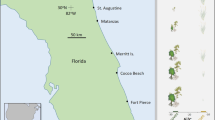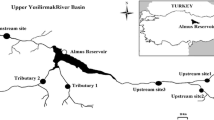Abstract
Each winter, populations of striped bass (Morone saxatilis) migrate north from the coastal mid-Atlantic region of the US to the coastal waters of New England. During this migration, striped bass spend significant time in estuaries and saltmarshes, presumably to forage. However, the extent to which saltmarsh productivity supports striped bass remains unresolved. We used a three-isotope Bayesian mixing model to determine the relative contribution of three primary producers [C4 saltmarsh cordgrass (Spartina spp.), phytoplankton, and benthic diatoms] to striped bass tissue. Phytoplankton (51 % contribution) and Spartina-derived sources (44 % contribution) are the primary sources of production to striped bass, while benthic diatoms made a relatively small contribution (5 %). Our results highlight the importance of saltmarshes to striped bass by showing that primary producers unique to saltmarsh ecosystems support a large proportion of striped bass production.


Similar content being viewed by others
References
Berggren, T., and J. Lieberman. 1978. Relative contribution of hudson, chesapeake, and roanoke striped bass, morone-saxatilis, stocks to atlantic coast fishery. Fishery Bulletin 76: 335–345.
Bigelow, H.B., and W.C. Schroeder. 1953. Fishes of the Gulf of Maine: US Government Printing Office Washington.
Boesch, D.F., and R.E. Turner. 1984. Dependence of fishery species on salt marshes: the role of food and refuge. Estuaries 7: 460–468.
Clark, J. 1968. Seasonal movements of striped bass contingents of Long Island Sound and the New York Bight. Transactions of the American Fisheries Society 97: 320–343.
Deegan, L.A. 1990. Effects of estuarine environmental conditions on population dynamics of young-of-the-year gulf menhaden. Marine Ecology Progress Series 68: 195–205.
Deegan, L.A., and R.H. Garritt. 1997. Evidence for spatial variability in estuarine food webs. Marine Ecology Progress Series 147: 31–47.
Deegan, L.A., D.S. Johnson, R.S. Warren, B.J. Peterson, J.W. Fleeger, S. Fagherazzi, and W.M. Wollheim. 2012. Coastal eutrophication as a driver of salt marsh loss. Nature 490: 388–392.
Fay, C.W., R.J. Neves, and G.B. Pardue. 1983. Species profiles: life histories and environmental requirements of coastal fishes and invertebrates (Mid-Atlantic). Striped Bass: Virginia Polytechnic Inst. and State Univ., Blacksburg (USA). Dept. of Fisheries and Wildlife Sciences.
Ferry, K.H., and M.E. Mather. 2012. Spatial and temporal diet patterns of subadult and small adult striped bass in Massachusetts estuaries: data, a synthesis, and trends across scales. Marine and Coastal Fisheries 4: 30–45.
Haines, E., and C. Montague. 1979. Food sources of estuarine invertebrates analyzed using 13C/12C ratios. Ecology 60: 48–56.
Harding, J.M., and R. Mann. 2001. Diet and habitat use by bluefish, Pomatomus saltatrix, in a Chesapeake Bay estuary. Environmental Biology of Fishes 60: 401–409.
Hussey, N.E., M.A. MacNeil, B.C. McMeans, J.A. Olin, S.F. Dudley, G. Cliff, S.P. Wintner, S.T. Fennessy, and A.T. Fisk. 2014. Rescaling the trophic structure of marine food webs. Ecology Letters 17: 239–250.
Jones, R.I., J. Grey, D. Sleep, and L. Arvola. 1999. Stable Isotope analysis of zooplankton carbon nutrition in humic lakes. Oikos 86: 97–104.
Kernehan, R.J., M.R. Headrick, and R.E. Smith. 1981. Early life history of striped bass in the Chesapeake and Delaware Canal and vicinity. Transactions of the American Fisheries Society 110: 137–150.
Kneebone, J., W.S. Hoffman, M.J. Dean, D.A. Fox, and M.P. Armstrong. 2014. Movement patterns and stock composition of adult Striped Bass tagged in Massachusetts coastal waters. Transactions of the American Fisheries Society 143: 1115–1129.
Leslie, H.M., and K.L. McLeod. 2007. Confronting the challenges of implementing marine ecosystem-based management. Frontiers in Ecology and the Environment 5: 540–548.
Lucena, F.M., T. Vaske, J.R. Ellis, and C.M. O’Brien. 2000. Seasonal variation in the diets of bluefish, Pomatomus saltatrix (Pomatomidae) and striped weakfish, Cynoscion guatucupa (Sciaenidae) in southern Brazil: implications of food partitioning. Environmental Biology of Fishes 57: 423–434.
Martínez del Rio, C., N. Wolf, S.A. Carleton, and L.Z. Gannes. 2009. Isotopic ecology ten years after a call for more laboratory experiments. Biological Reviews 84: 91–111.
Mather, M.E., J.T. Finn, K.H. Ferry, L.A. Deegan, and G.A. Nelson. 2009. Use of non-natal estuaries by migratory striped bass (Morone saxatilis) in summer.
Mather, M., J. Finn, C. Kennedy, D. L.A., and J.M. Smith. 2013. What happens in an estuary doesn’t stay there: patterns of biotic connectivity resulting from long term ecological research. Oceanography 26: 168–179.
Mather, M.E., J.T. Finn, C.G. Kennedy, L.A. Deegan, and J.M. Smith. 2013. What happens in an estuary doesn’t stay there: patterns of biotic connectivity resulting from long term ecological research.
Merriman, D. 1941. Studies on the striped bass (Roccus saxatilis) of the Atlantic coast: US Government Printing Office.
Millennium Ecosystem Assessment, 2005. Ecosystems and Human Well-being: Synthesis. Island Press, Washington, DC.
Minagawa, M., and E. Wada. 1984. Stepwise enrichment of 15 N along food chains: further evidence and the relation between δ 15 N and animal age. Geochimica et Cosmochimica Acta 48: 1135–1140.
Nelson, G.A., B.C. Chase, and J. Stockwell. 2003. Food habits of striped bass (Morone saxatilis) in coastal waters of Massachusetts. Journal of Northwest Atlantic Fishery Science 32: 1.
Nelson, J., J. Chanton, F. Coleman, and C. Koenig. 2011. Patterns of stable carbon isotope turnover in gag, Mycteroperca microlepis, an economically important marine piscivore determined with a non-lethal surgical biopsy procedure. Environmental Biology of Fishes 90: 243–252.
Nelson, J.A., L.A. Deegan, and R.H. Garritt. 2015. Drivers of spatial and temporal variability in estuarine food webs. Marine Ecology Progress Series 533: 67–77.
Overton, A.S., C.S. Manooch III, J.W. Smith, and K. Brennan. 2008. Interactions between adult migratory striped bass (Morone saxatilis) and their prey during winter off the Virginia and North Carolina Atlantic coast from 1994 through 2007. Fishery Bulletin 106: 174–182.
Overton, A.S., F.J. Margraf, and E.B. May. 2009. Spatial and temporal patterns in the diet of striped bass in Chesapeake Bay. Transactions of the American Fisheries Society 138: 915–926.
Parnell, A.C., R. Inger, S. Bearhop, and A.L. Jackson. 2010. Source partitioning using stable isotopes: coping with too much variation. PloS One 5: e9672.
Pautzke, S.M., M.E. Mather, J.T. Finn, L.A. Deegan, and R.M. Muth. 2010. Seasonal use of a New England estuary by foraging contingents of migratory striped bass. Transactions of the American Fisheries Society 139: 257–269.
Peterson, B.J., and B. Fry. 1987. Stable isotopes in ecosystem studies. Annual review of ecology and systematics: 293–320.
Post, D.M. 2002. The long and short of food-chain length. Trends in Ecology & Evolution 17: 269–277.
Rast, W., and J. Sutton. 1985. Use of stable carbon and nitrogen isotopes to trace the larval striped bass food chain in the Sacramento-San Joaquin Estuary. California, April to September: 88-164.
Schaefer, R.H. 1968. Sex composition of striped bass from the Long Island surf: Department of Environmental Conservation.
Secor, D.H., and P.M. Piccoli. 2007. Oceanic migration rates of Upper Chesapeake Bay striped bass (Morone saxatilis), determined by otolith microchemical analysis. Fishery Bulletin 105: 62–73.
Setzler-Hamilton, E.M., W.R. Boynton, J.A. Mihursky, T.T. Polgar, and K.V. Wood. 1981. Spatial and temporal distribution of striped bass eggs, larvae, and juveniles in the Potomac estuary. Transactions of the American Fisheries Society 110: 121–136.
Tobias, C., A. Giblin, J. McClelland, J. Tucker, and B. Peterson. 2003. Sediment DIN fluxes and preferential recycling of benthic microalgal nitrogen in a shallow macrotidal estuary. Marine Ecology Progress Series 257: 25–36.
Vander Zanden, M.J., M.K. Clayton, E.K. Moody, C.T. Solomon, and B.C. Weidel. 2015. Stable isotope turnover and half-life in animal tissues: a literature synthesis. PloS One 10: e0116182.
Wainright, S.C., C.M. Fuller, R.H. Michener, and R.A. Richards. 1996. Spatial variation of trophic position and growth rate of juvenile striped bass (Morone saxatilis) in the Delaware River. Canadian Journal of Fisheries and Aquatic Sciences 53: 685–692.
Westin, D.T., and B.A. Rogers. 1978. Synopsis of Biological Data on the Striped Bass, Mo̲r̲o̲n̲e̲ ̲sa̲x̲a̲t̲i̲l̲i̲s̲ ̲ (Walbaum) 1972: Graduate School of Oceanography, University of Rhode Island.
Zhao, L., C. Chen, J. Vallino, C. Hopkinson, R.C. Beardsley, H. Lin, and J. Lerczak. 2010. Wetland-estuarine-shelf interactions in the Plum Island Sound and Merrimack River in the Massachusetts coast. Journal of Geophysical Research: Oceans 115: n/a-n/a.
Acknowledgments
The authors are grateful to the many interns who participated in the collection of the samples, especially David Behringer, John Pirie, Dane Nelson, and Beau Nelson. Special thanks to M. Otter for isotopic analysis. Many thanks to L. Deegan for her input on the writing of this manuscript. M. Mather for advising on the set up of the study. Funding for this research was provided by the Plum Island Ecosystems LTER (NSF-OCE 1238212), TIDE Project (NSF-DEB 0816963, 1354494), and the Northeast Climate Science Center. Research support was also provided to H. Baker by the Marine Biological Laboratory and Brown University’s Biology Program.
Author information
Authors and Affiliations
Corresponding author
Additional information
Communicated by Craig Tobias
Rights and permissions
About this article
Cite this article
Baker, H.K., Nelson, J.A. & Leslie, H.M. Quantifying Striped Bass (Morone saxatilis) Dependence on Saltmarsh-Derived Productivity Using Stable Isotope Analysis. Estuaries and Coasts 39, 1537–1542 (2016). https://doi.org/10.1007/s12237-016-0092-2
Received:
Revised:
Accepted:
Published:
Issue Date:
DOI: https://doi.org/10.1007/s12237-016-0092-2




